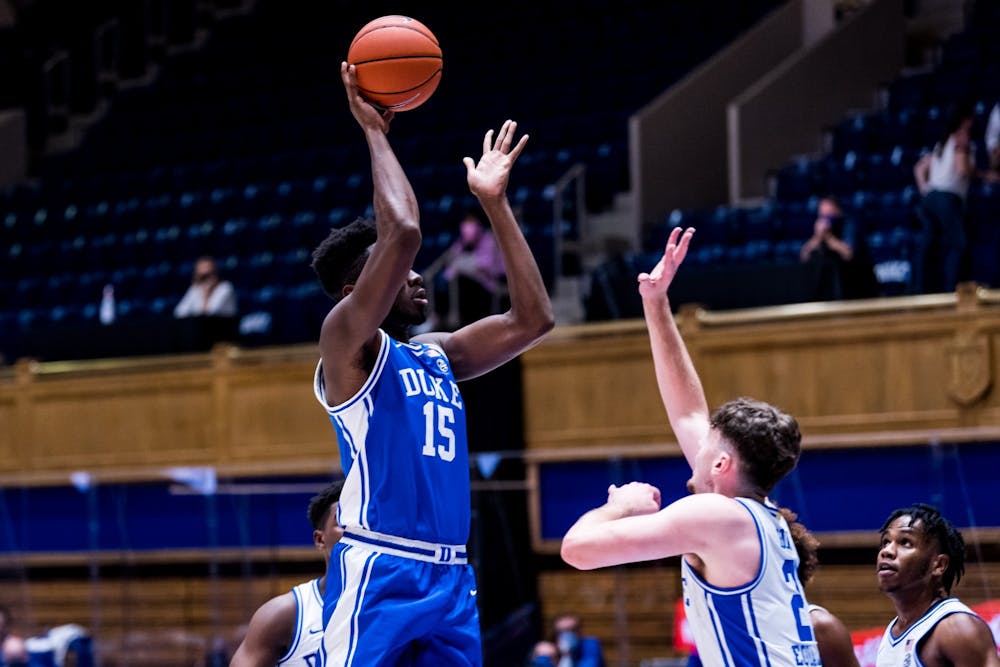Basketball season is nearly upon us, and as Duke men's basketball's first matchup with Gardner Webb approaches, the Blue Zone breaks down this year's squad in comparison to the 2019-20 team. There is a lot of talent and numerous uncertainties that will make this team exciting to follow.
Depth
At first glance, the 2020-21 team is unlike any other squad in recent years, primarily because it boasts both a large freshman class and several key returners from last year. What this means is that head coach Mike Krzyzewski may try for a deeper rotation.
While Vernon Carey Jr. and Tre Jones were the go-to players last year, this team has a lot of talented and experienced players on the roster, so we could see a much more balanced offense than before. At the same time, the minutes per game played by the core players could go down with this deep pool of talent, so this year’s team may not have one player with stats way above everyone else.
Inner and outer presence
With a three-guard starting lineup last season, this year’s deep roster has made it likely that Krzyzewski will start three forwards—Matthew Hurt, Wendell Moore Jr. and Jalen Johnson. While this may somewhat remind the Duke fans of the 2018-19 season, where forwards Zion Williamson, RJ Barrett and Cam Reddish made up the core of the starting lineup, this year’s lineup is more or less headlined by players who play with a much higher level of versatility.
Johnson has the height of a power forward, but also possesses the court vision and passing ability of a point guard. On the other hand, Hurt, who bulked up during the offseason, is expected to be able to play better on the inside while still scoring efficiently from the three-point line.
Moore’s versatility is no different, as his lockdown perimeter defense could place him anywhere on the court, and with his improved shooting, we could see an effective mid-range game that he can mix in with his already fine-tuned driving skills.
With the addition of Mark Williams and Patrick Tapé, Duke can develop tough-enough rim protection on the defensive end. The roles for this year’s players are not as defined as last year, making this season all the more intriguing. We are yet to see who will rise up as the go-to scorer in this young front court, something that has been important for the success of previous teams.
Speed
This year’s team is more or less forward heavy, as Hurt and Moore are both projected to play large roles this season, and Johnson, their most highly-recruited freshman, is also expected to start. But this doesn’t mean the team will look like the 2018-19 team, as it is unclear if there will be a dominant post player.
With the return of Joey Baker, Hurt and Moore, along with the arrival of freshman guards DJ Steward and Jeremy Roach, Duke could adapt a small-ball lineup with a quicker style of playing thanks to their ability to shoot the ball from all over the floor.
Experience
While Hurt and Baker have already established themselves as capable sharpshooters from beyond the arc, Moore is also set to break out offensively this season. Jordan Goldwire, the only senior who will see significant minutes on the roster, can lead the team and will likely start to begin the season. Tapé, despite being new to the program, has had three years of playing experience as Columbia’s center and could serve as a mentor for Williams.
Perhaps one of the weaknesses for this year’s team is the lack of March Madness experience, as only Goldwire has logged any minutes in the NCAA tournament. But since March is the time where anything can happen, what matters more is how the team can bond and develop along the way.
Get The Chronicle straight to your inbox
Signup for our weekly newsletter. Cancel at any time.

